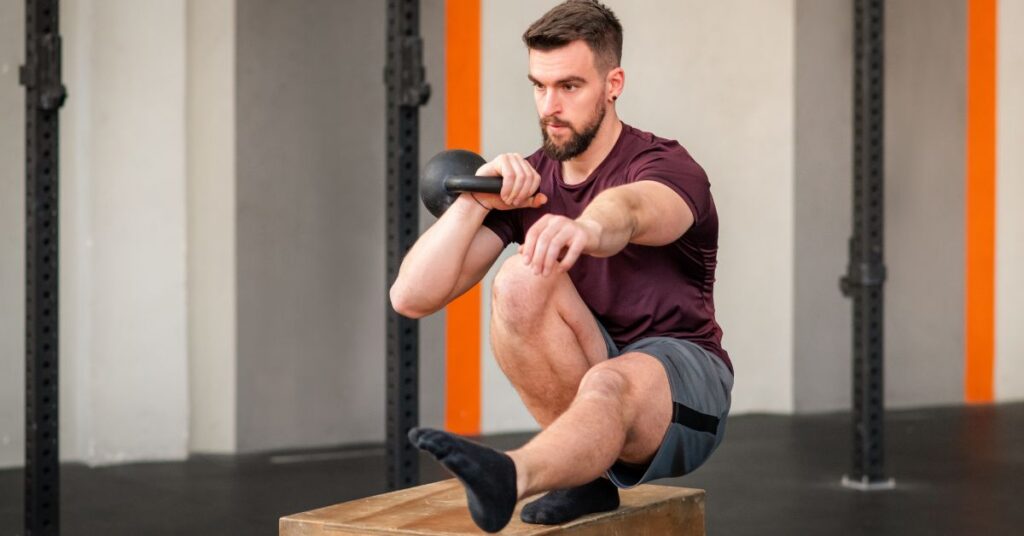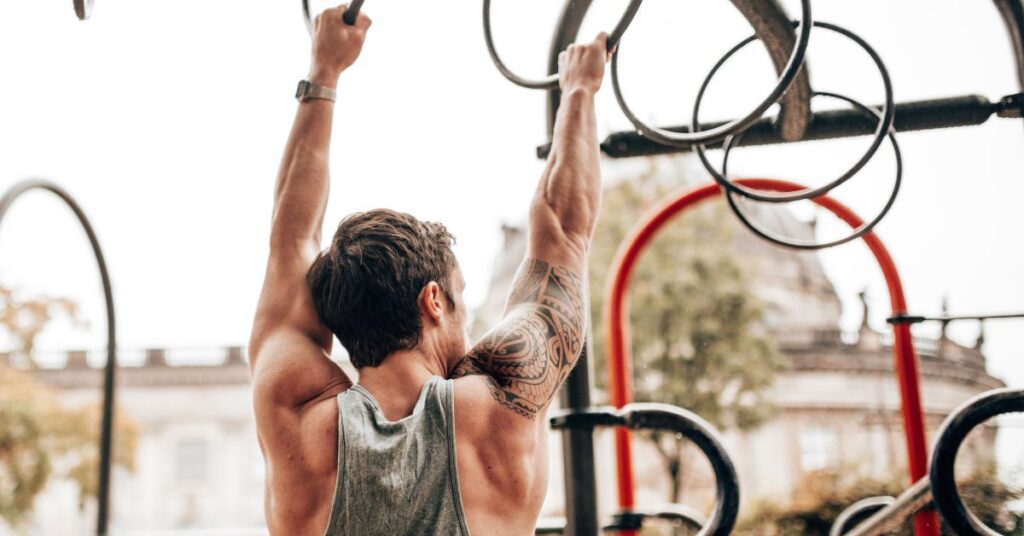The 8 Calisthenics Handstand steps are: Wrist Preparation, Shoulder Mobility, Core Activation, Wall Handstand Hold, Chest-to-Wall Handstand, Kick-up Practice, Freestanding Balance, and Handstand Refinement.
Learning how to do calisthenics handstand is one of the most rewarding skills in bodyweight training. This incredible movement combines strength, balance, and body awareness into a single impressive display of human capability. Whether you’re a complete beginner or someone who has tried handstands before, understanding how to do calisthenics handstand properly will accelerate your progress and help you avoid common mistakes. This comprehensive guide covers everything from basic prerequisites to advanced techniques, ensuring you have all the knowledge needed to master this fundamental calisthenics skill. By following the proven methods outlined here, you’ll discover that learning how to do calisthenics handstand is achievable with dedication and proper technique.
Table of Contents
How to do Calisthenics Handstand Step by Step?
Learning how to do calisthenics handstand requires a systematic approach that builds strength, balance, and confidence progressively. This step-by-step method ensures you develop proper form while minimizing injury risk. Follow these proven steps to master your handstand safely and effectively.
| Step | Focus Area | Duration | Difficulty |
| 1 | Wrist Preparation | 2-3 minutes | Beginner |
| 2 | Shoulder Mobility | 3-5 minutes | Beginner |
| 3 | Core Activation | 2-3 minutes | Beginner |
| 4 | Wall Handstand Hold | 30-60 seconds | Beginner |
| 5 | Chest-to-Wall Handstand | 30-60 seconds | Intermediate |
| 6 | Kick-up Practice | 10-15 attempts | Intermediate |
| 7 | Freestanding Balance | 5-30 seconds | Advanced |
| 8 | Handstand Refinement | Ongoing | Advanced |
Explore the best body weight training equipment for your home workouts.
Step 1: Wrist Preparation
Begin your journey of how to do calisthenics handstand by preparing your wrists for the intense pressure they’ll face. Perform wrist circles, prayer stretches, and gentle flexion exercises. This preparation prevents injury and improves comfort during handstand practice, making it essential for safe training.
Step 2: Shoulder Mobility
Proper shoulder mobility is crucial for learning how to do calisthenics handstand effectively. Perform arm circles, shoulder rolls, and overhead stretches to open tight shoulders. Limited shoulder mobility prevents proper handstand alignment and increases injury risk, making this step non-negotiable for success.
Step 3: Core Activation
Activate your core muscles through hollow body holds and planks before attempting handstand positions. Strong core engagement is fundamental to how to do calisthenics handstand with proper form. This activation teaches the body tension necessary for stable handstand holds and prevents common alignment issues.
Step 4: Wall Handstand Hold
Practice wall-supported handstands to build strength and familiarity with the inverted position. Place hands arm’s length from wall and walk feet up until inverted. This foundation step in how to do calisthenics handstand builds confidence while developing the specific strength needed for freestanding attempts.
Step 5: Chest-to-Wall Handstand
Progress to chest-to-wall handstands for improved body alignment and shoulder positioning. Face the wall with hands close to base and walk feet up until chest faces wall. This variation teaches proper handstand form and is essential for learning how to do calisthenics handstand correctly.
Step 6: Kick-up Practice
Learn the dynamic movement required to enter handstand position through kick-up practice. Start in lunge position and practice kicking up to handstand while maintaining control. This skill bridges the gap between wall-supported practice and freestanding handstands in how to do calisthenics handstand training.
Step 7: Freestanding Balance
Attempt freestanding handstands by reducing wall contact gradually. Practice short holds while focusing on balance and control rather than duration. This advanced step in how to do calisthenics handstand requires patience and consistent practice to master effectively and safely.
Step 8: Handstand Refinement
Continuously refine your handstand technique through regular practice and attention to detail. Focus on extending hold times, improving form, and developing consistency. This ongoing process ensures your understanding of how to do calisthenics handstand continues evolving and improving over time.
Try these effective unilateral exercises to build balanced strength and improve overall performance.
Tips for Doing a Handstand
Success in handstands comes from consistent practice, proper technique, and patience with the learning process. These fundamental tips will accelerate your progress while preventing common mistakes. Focus on building strong foundations rather than rushing to achieve the final position.
- Start with wall support – Face away from wall initially, then progress to chest-to-wall for better alignment
- Perfect your hollow body position – Engage core, tuck pelvis, and create straight line from hands to feet
- Focus on finger pressure – Use fingertips to make micro-adjustments and prevent falling forward or backward
- Keep shoulders directly over wrists – Avoid letting shoulders drift forward, which causes immediate collapse
- Look at hands, not forward – Maintain neutral neck position to preserve spinal alignment throughout hold
- Practice kick-ups consistently – Develop consistent entry technique rather than relying on different approaches each time
- Warm up thoroughly – Spend 10-15 minutes on wrist, shoulder, and thoracic spine mobility before training
- Film yourself training – Video feedback reveals alignment issues and progress that you can’t feel during practice
- Stay patient and consistent – Handstands take months to years to master; celebrate small improvements along the way
Does Handstands Build Muscle?
Handstands are exceptional compound exercises that simultaneously target multiple muscle groups while demanding significant strength and coordination. Unlike traditional weightlifting, handstand training builds functional strength through bodyweight resistance, developing muscles in ways that translate directly to real-world movement patterns and athletic performance.
The inverted position creates unique training stimulus by loading the shoulders, arms, and core with your entire body weight. Primary muscle groups activated include deltoids, triceps, latissimus dorsi, serratus anterior, and deep core stabilizers. Secondary benefits include improved wrist and forearm strength, enhanced proprioception, and increased bone density in the upper body through weight-bearing exercise.
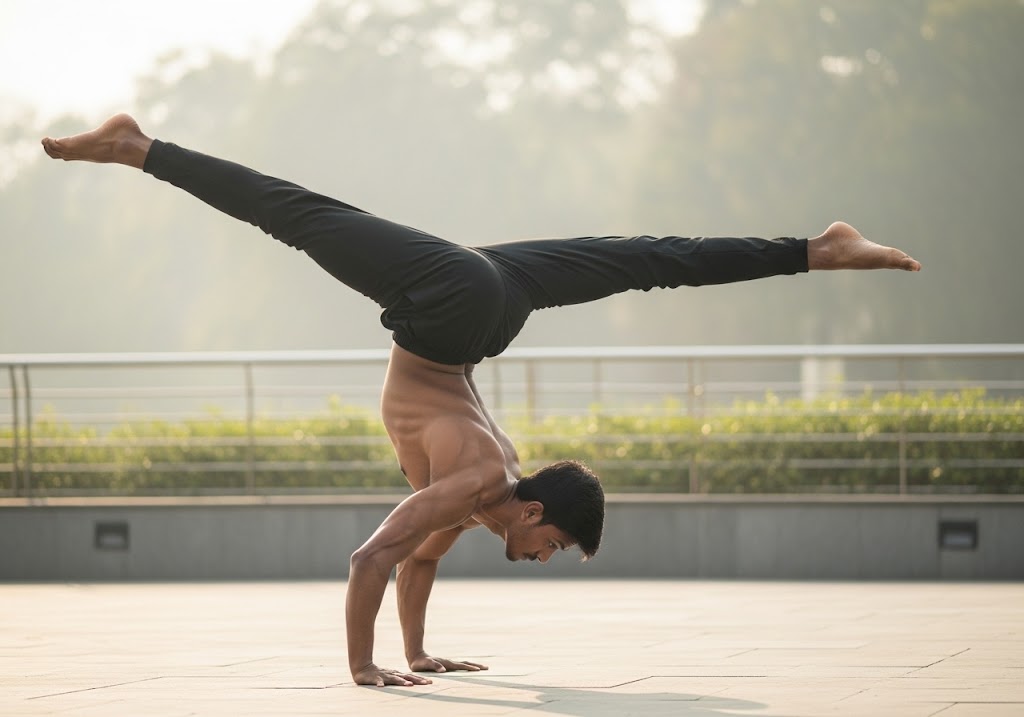
What is Calisthenics Handstand?
A calisthenics handstand is a fundamental bodyweight exercise where you support your entire body weight on your hands while maintaining perfect vertical alignment. This skill represents the intersection of strength, balance, and body control, making it one of the most respected movements in calisthenics vs gymnastics training. Learning how to do calisthenics handstand involves developing the ability to hold your body in a straight line from wrists to toes while inverted.
The calisthenics handstand serves as a foundation for numerous advanced movements including handstand push-ups, handstand walks, and various handstand holds. Unlike gymnastic handstands that emphasize perfect form for competition, calisthenics handstands focus on functional strength and practical application. This approach makes learning how to do calisthenics handstand more accessible while still demanding significant strength, flexibility, and dedication to master effectively.
Learn how to do a perfect squat step-by-step and avoid common mistakes that hold you back.
Calisthenics Handstand for Beginners
Beginning your journey of how to do calisthenics handstand requires understanding fundamental prerequisites and safety principles. This beginner-focused approach ensures you build proper foundations while avoiding common mistakes that can hinder progress or cause injury.
| Prerequisite | Requirement | Time to Develop |
| Wrist Flexibility | Pain-free weight bearing | 2-4 weeks |
| Shoulder Mobility | Overhead reach without arching | 2-6 weeks |
| Core Strength | 60-second plank hold | 4-8 weeks |
| Upper Body Strength | 10+ push-ups | 4-12 weeks |
| Balance Awareness | Single-leg stands | 1-2 weeks |
| Fear Management | Comfortable with inversion | 2-8 weeks |

Calisthenics Handstand Equipment
While learning how to do calisthenics handstand can be done without equipment, certain tools can significantly accelerate your progress and improve training comfort. These equipment options help reduce wrist stress and provide stability for safer practice sessions.
- Handstand Bars: Parallel bars that reduce wrist stress and provide comfortable grip for extended practice sessions
- Handstand Canes: Portable handles that offer wrist relief and easy storage for convenient practice anywhere
- Yoga Mat: Provides cushioning and grip for floor practice, essential for comfortable handstand training
- Wall Space: Clear wall area for supported practice, crucial for safe progression in handstand development
- Parallettes: Low parallel bars excellent for handstand training and calisthenics at home no equipment alternatives
- Resistance Bands: Useful for shoulder strengthening and mobility work supporting handstand development
See how many calories does 100 jumping jacks burn and the impact of how many calories does 300 jumping jacks burn.
Handstand Calisthenics Progression
Systematic progression is essential for learning how to do calisthenics handstand safely and effectively. This structured approach ensures you build necessary strength and skill at each level before advancing to more challenging variations.
| Progression Level | Exercise | Hold Time | Difficulty |
| Level 1 | Wall Handstand (back to wall) | 30-60 seconds | Beginner |
| Level 2 | Chest-to-Wall Handstand | 30-60 seconds | Beginner |
| Level 3 | Hollow Body Hold | 30-60 seconds | Beginner |
| Level 4 | Pike Push-ups | 8-12 reps | Intermediate |
| Level 5 | Handstand Kick-up Practice | 10-15 attempts | Intermediate |
| Level 6 | Freestanding Handstand | 5-30 seconds | Advanced |
| Level 7 | Handstand Push-ups | 1-5 reps | Advanced |
| Level 8 | Handstand Walk | 5-10 steps | Expert |
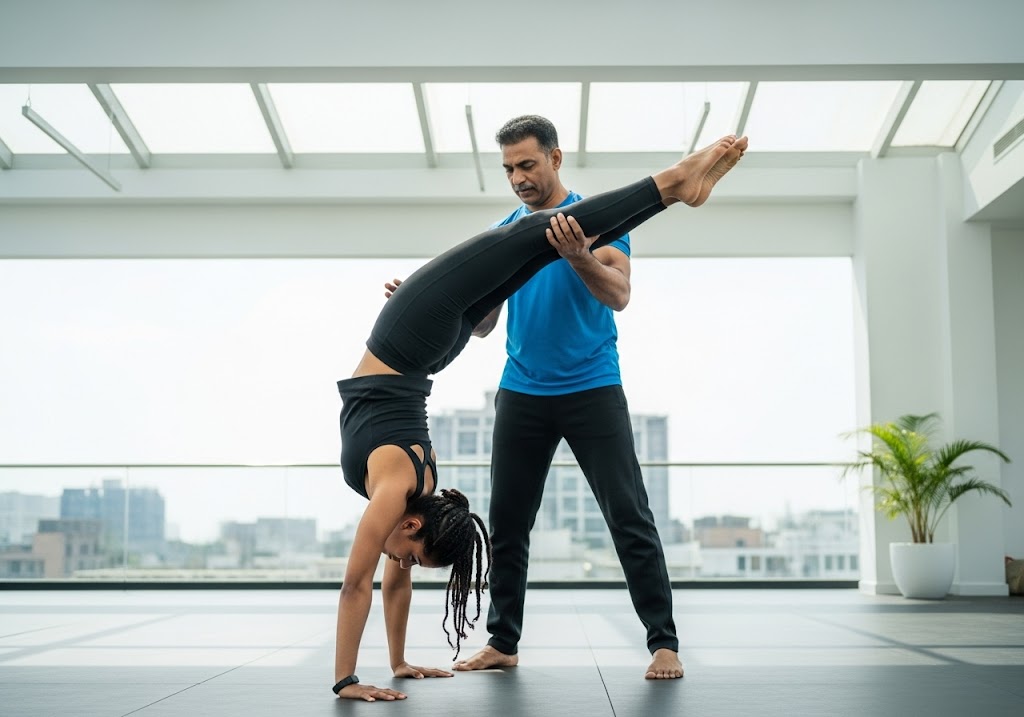
Essential Calisthenics Handstand Exercises
Building the strength and skill necessary for how to do calisthenics handstand requires specific exercises that target handstand-related movement patterns. These exercises develop the precise strength, flexibility, and coordination needed for handstand success.
| Exercise | Primary Benefit | Sets x Reps | Progression |
| Pike Push-ups | Shoulder strength | 3 x 8-12 | Increase reps/elevation |
| Hollow Body Hold | Core stability | 3 x 30-60s | Increase hold time |
| Wrist Conditioning | Injury prevention | Daily x 2-3 min | Increase complexity |
| Crow Pose | Balance/coordination | 3 x 15-30s | Increase hold time |
| Wall Handstand | Specific strength | 3 x 30-60s | Reduce wall support |
| Shoulder Shrugs | Shoulder stability | 3 x 10-15 | Add resistance |
Master skills like the impressive calisthenics human flag.
Calisthenics Workout for Handstands
This comprehensive workout develops all physical qualities needed for handstand mastery. Combine strength, mobility, and skill work in each session. Perform 3-4 times weekly, allowing rest days for recovery and adaptation while maintaining consistent progress toward your handstand goals.
| Training Phase | Exercise | Volume | Intensity | Rest Period | Key Coaching Cues |
|---|---|---|---|---|---|
| Phase 1: Preparation | Shoulder dislocations, Wrist prep sequence, Thoracic spine rolls | 15 reps, 10 each direction, 8-10 reps | Light/Moderate | 30 seconds | Open shoulders fully, No pain in wrists, Slow controlled movement |
| Phase 2: Activation | Bear crawl, Dead bug holds, Scapular wall slides | 20 steps forward/back, 10 each side x 5s, 12-15 slow reps | Moderate | 45 seconds | Neutral spine, Opposite arm/leg, Full protraction |
| Phase 3: Strength | Elevated pike push-ups, L-sit progression, Handstand shrugs | 4 sets x 6-10, 4 sets x 10-20s, 3 sets x 8-12 | High | 90 seconds | Nose to floor, Shoulders down, Active shoulders |
| Phase 4: Skill Work | Chest-to-wall HS, Hollow body rocks, Kick-up drills | 3 sets x 30-60s, 3 sets x 15 reps, 20 total attempts | Moderate/High | 2 minutes | Perfect alignment, No momentum, Same leg every time |
| Phase 5: Integration | Freestanding practice, Wall facing away, Balance challenges | 20 attempts, 3 sets x 45s, Various exercises | Maximum effort | 3 minutes | Quality over quantity, Gradual wall distance, Stay relaxed |
| Phase 6: Recovery | Downward dog, Chest doorway stretch, Wrist flexor stretch | 60 seconds, 45 seconds, 30s each arm | Light | Minimal | Deep breathing, Gentle pressure, No bouncing |
Handstand Training Routine
This structured routine balances strength building, skill development, and recovery. Train 4-5 times weekly, focusing on quality over quantity. Each session builds upon previous work while introducing new challenges to accelerate your handstand journey through consistent, progressive training.
| Day | Primary Focus | Exercises | Sets x Reps/Time | Rest |
|---|---|---|---|---|
| Monday | Strength Building | Pike push-ups, Hollow body holds, Wall handstand | 3×8-12, 3×30-45s, 3×45-60s | 90s between sets |
| Tuesday | Balance & Skill | Crow pose, Kick-up practice, Freestanding attempts | 3x30s, 5×3 attempts, 10 total attempts | 60s between sets |
| Wednesday | Active Recovery | Shoulder mobility, Wrist circles, Light stretching | 2×10 each direction, 20 each way, 10-15 minutes | As needed |
| Thursday | Endurance | Wall handstand, Pike walks, Hollow rocks | 2×60-90s, 3×8-10 steps, 3×15-20 | 60s between sets |
| Friday | Skill Integration | Freestanding practice, Wall transitions, Hold challenges | 15 minutes, 5×5 attempts, Max hold test | 2-3 minutes |
Calisthenics Handstand Push Up
The calisthenics handstand push up represents the ultimate expression of vertical pressing strength in bodyweight training. This advanced movement requires mastery of the basic handstand before attempting, as it combines balance with intense upper body strength demands.
| Progression | Requirements | Difficulty | Prerequisites |
| Wall HSPU (partial) | 30s wall handstand | Intermediate | Solid wall handstand |
| Wall HSPU (full ROM) | Strong wall handstand | Advanced | Multiple wall HSPUs |
| Freestanding HSPU | 30s freestanding handstand | Expert | Consistent freestanding handstand |
| Deficit HSPU | Advanced handstand strength | Expert | Multiple freestanding HSPUs |
| One-Arm HSPU | Elite strength level | Master | Years of dedicated training |
How to Progress to Handstand Push-ups?
Handstand push-ups require exceptional upper body strength and control. Progress gradually through these movements, ensuring you can hold a solid handstand for 30+ seconds before attempting push-ups. Focus on eccentric control first, then build concentric strength through these progressive steps.
- Master the freestanding handstand – Hold for 30+ seconds consistently with perfect form and balance
- Develop pike push-up strength – Complete 15+ reps with feet elevated to simulate handstand angle
- Practice wall-assisted negatives – Lower slowly from handstand to headstand position against wall (5-10 seconds down)
- Work partial range of motion – Lower only halfway down initially, gradually increasing range over weeks
- Use parallettes or push-up handles – Reduces wrist strain and allows deeper range of motion for progression
- Focus on hollow body position – Maintain tight core throughout movement to prevent back arch and energy leaks
- Build up volume gradually – Start with 3-5 negatives, progress to partial reps, then full range push-ups
- Strengthen supporting muscles – Include overhead press, pike push-ups, and shoulder stability exercises regularly
Understand the key differences in unilateral vs bilateral training and how to use both for optimal results.
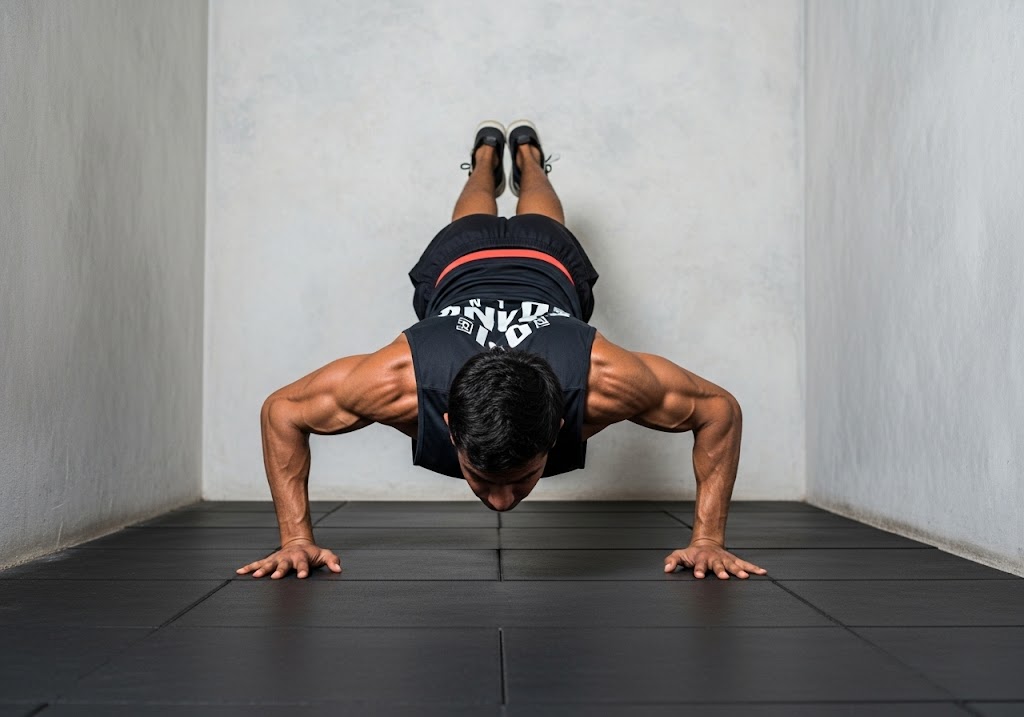
Creating Your Handstand Workout Routine
Developing an effective routine for learning how to do calisthenics handstand requires balancing skill practice, strength building, and recovery. This structured approach ensures consistent progress while preventing overtraining and injury through your handstand journey.
- Warm-up Protocol: 10-15 minutes of wrist mobility, shoulder circles, and light cardio preparation
- Skill Practice: 20-30 minutes focused on your current handstand progression level
- Strength Training: 15-20 minutes of supporting exercises like pike push-ups and hollow holds
- Cool-down Routine: 5-10 minutes of stretching and relaxation to promote recovery
- Training Frequency: 3-4 sessions per week with rest days for adaptation and growth
- Progress Tracking: Record hold times and subjective feelings to monitor improvement
Explore the most effective calisthenics exercises to build strength, mobility, and control using just your bodyweight.
Common Mistakes and How to Avoid Them
Learning how to do calisthenics handstand involves navigating common errors that can slow progress or cause injury. Understanding these mistakes and their solutions helps you train more effectively while maintaining safety throughout your handstand development.
- Rushing Through Progressions: Attempting advanced variations before mastering basics leads to poor form and potential injury
- Inadequate Wrist Preparation: Skipping wrist warm-ups causes pain and limits practice time significantly
- Poor Body Alignment: Arching back or bending legs creates instability and prevents balance development
- Inconsistent Practice: Sporadic training prevents neuromuscular adaptations necessary for handstand success
- Fear of Falling: Anxiety about inversion prevents progress and limits skill development potential
- Neglecting Back Calisthenics: Weak posterior chain muscles affect handstand posture and stability

Advanced Handstand Techniques
Once you’ve mastered the basics of how to do calisthenics handstand, advanced techniques open new possibilities for skill development and strength building. These techniques require solid handstand foundations and should only be attempted after achieving consistent freestanding handstands.
Advanced practitioners often incorporate handstand training into comprehensive routines that include calisthenics pull workout sessions and calisthenics planche training. This integrated approach develops balanced strength while maintaining handstand-specific skills.
The question of does calisthenics build muscle is clearly answered through handstand training, as this skill develops significant upper body mass and strength. Advanced handstand variations provide continuous challenges for muscle growth and strength development.
Conclusion
Learning how to do calisthenics handstand is a rewarding journey that develops strength, balance, and confidence through systematic progression. With consistent practice and proper technique, anyone can master this fundamental calisthenics skill and unlock advanced movement possibilities for continued growth.
Want to master the calisthenics handstand and take your skills to the next level? Whether you’re a beginner or pushing advanced skills, ISC – Indian School of Calisthenics offers expert guidance to help you master bodyweight training. Visit us at SRPF Ground, NH8, Goregaon (E), Mumbai – 400065. For class schedules, personalized coaching, or more details, call +91 77159 53218. Train smart, move better, and unlock your back strength with ISC.
How to do Calisthenics Handstand? – FAQs
How long does it take to learn a calisthenics handstand?
The time it takes to learn a handstand varies by individual, depending on factors such as prior strength, flexibility, and practice frequency. With consistent training, many beginners can achieve a wall-supported handstand within a few weeks.
Can I practise handstand at home?
Yes, handstand can be practiced at home, provided you have a safe space. Make sure to use a soft surface or mat and consider using a wall for support as you learn.
What are some common mistakes to avoid when learning calisthenics handstand?
Common mistakes include not engaging the core, improper shoulder positioning, and lacking grip strength. Focus on maintaining a straight body line and engage your core throughout the movement.
Is it necessary to have a coach to learn handstand?
While having a coach can provide valuable feedback and guidance, many people successfully learn calisthenics handstand through self-practice and online resources. A coach can help accelerate progress, especially in advanced techniques.
Are handstands safe for everyone?
Most individuals can practice handstand safely; however, those with certain medical conditions, especially related to the shoulders or wrists, should consult a healthcare professional before starting. Always listen to your body and avoid pushing through pain.
What muscles do calisthenics handstands work?
Calisthenics handstands primarily target the shoulders, arms, core, and upper back, while also engaging wrist and hand stabilizers for balance.
How often should I train handstands in a week?
Practising 3–5 times a week allows consistent progress while giving your muscles and joints time to recover, especially if you’re also strength training.
Should I use the wall or go freestanding first?
Start with wall-supported handstands to build strength and alignment before progressing to freestanding versions for balance and control.
Can handstands improve posture and core strength?
Yes, calisthenics handstands enhance core engagement and spinal alignment, which can lead to better posture and improved core stability.
Do I need to warm up before practising handstands?
Absolutely. A proper warm-up that includes wrist mobility, shoulder activation, and light cardio prepares your body for safe and effective training.

